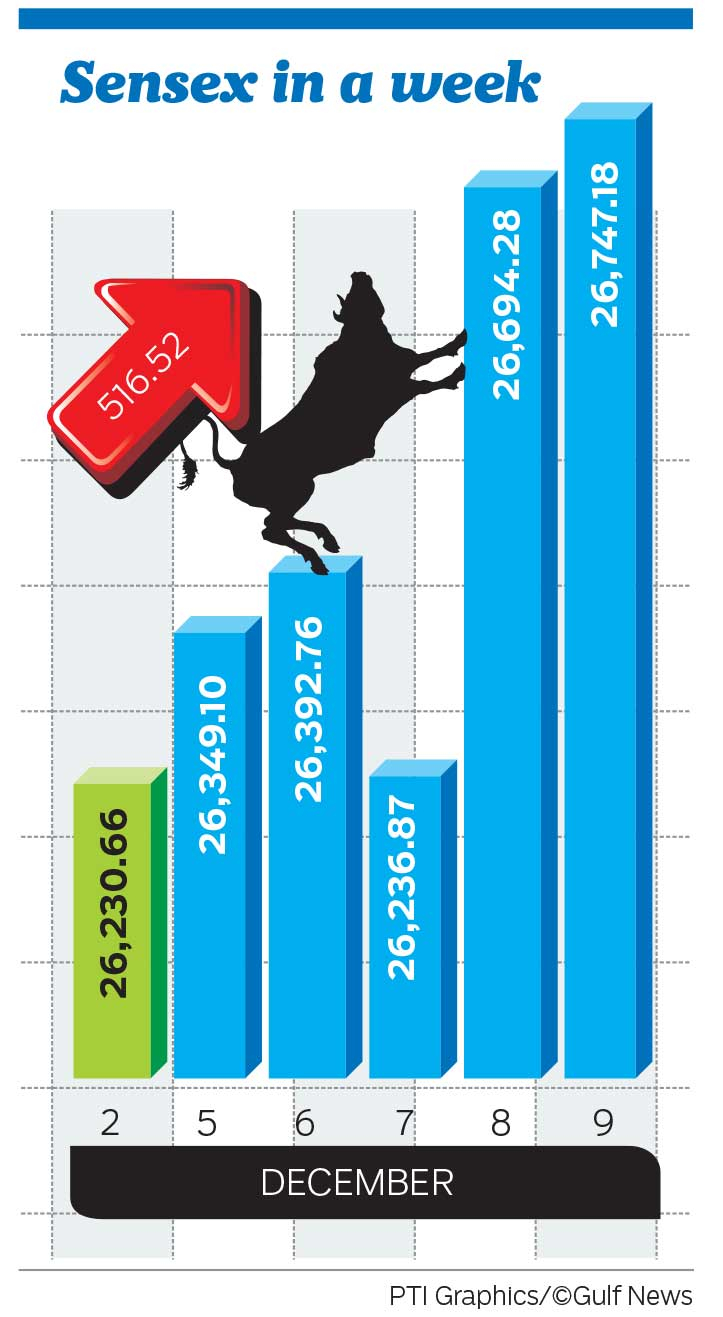Resilient investors propelled shares in India to their strongest weekly gains in more than three months as they shrugged off disappointment over the central bank’s decision to keep at bay a widely expected interest rate cut and focused on the longer term growth outlook.
The Reserve Bank of India (RBI) surprised economists and markets alike on Wednesday by holding its repo rate unchanged at a six-year low of 6.25 per cent, citing uncertain global and domestic factors, much to the chagrin of consensus market view for a 25 basis points reduction.
The central bank lowered its forecast for gross value-added growth — a key component of GDP — in 2016-17 to 7.1 per cent from 7.6 per cent projected earlier, but added that the disruption caused by withdrawal of high-value bank notes that comprised 86 per cent of the total currency in circulation would be temporary.
Global investment bank Morgan Stanley believes the $2 trillion economy would bounce back in about 4-5 months.
“We maintain our overall constructive outlook on India,” US bank said in a note its clients. “We expect growth to be back on the recovery track from the second quarter of 2017 after a short period of slowdown between November 2016 and March 2017, due to the currency replacement programme.”
Consumption, which accounts for 60 per cent of GDP, would pick up from the quarter ending June, and the recovery would broaden following higher public capital spending and foreign direct investment flows, it said.
The report said that global growth is expected to accelerate to 3.4 per cent in 2017 from 3 per cent in 2016, which would bolster India’s exports and support an overall recovery after being a drag this year.
Investors agreed with the assessment. The top-30 Sensex climbed 2 per cent over the week to 26,747.18 and the 50-share Nifty rose 2.2 per cent to 8,261.75, both posting their biggest gain since the week ended September 2.
India is one of our top emerging market picks, Morgan Stanley said, adding that equity valuations relative to bonds are the best since 2013.
“In our view, equities are likely to deliver 14 per cent INR (Indian rupee) returns in 2017, compared with (-) 3 per cent in 2015 and 2016,” it said.
Short-term pain
There is no doubt, however, that the near-term outlook is troublesome.
The abrupt demonetisation of Rs1,000 and Rs500 notes on November 8 has rocked the economy in good measure. With the authorities unable to supply adequate new notes — the gap is wider than the Grand Canyon — an acute cash shortage has dented consumer spending, curtailed factory activity and caused much anguish among the people.
Against about Rs12 trillion defunct currency notes deposited in banks until early December, the central bank has been able to replace just over Rs3 trillion in new notes. The government has been pushing digital transactions to tide over the crisis, but tens of millions of poor that reside in rural regions have little access to the facility.
In a sign of how this would play out services activity contracted in November for the first time in 16 months, and the situation is likely to remain bad for the next few months.
The Nikkei/Markit Services Purchasing Managers’ Index fell to 46.7 from October’s 54.5. It was in June 2015 when the reading went below 50 that separates growth from contraction. The fall was also the biggest since November 2008, just after the collapse of Lehman Brothers triggered the global financial crisis.
“The latest set of gloomy PMI figures for the Indian service sector shows that companies were heavily impacted by the 500 and 1,000 rupee notes ban,” said Pollyana De Lima, economist at survey compiler IHS Markit.
Financial services, hotels, restaurants, renting and business activities suffered the most as consumers curbed discretionary spending. As the services sector contributes more than 60 per cent of gross domestic product, the contraction is likely to drastically weaken the growth outlook.
Economists at Goldman Sachs said economic growth in the December quarter could tumble to 4 per cent, sharply lower than the reduced forecast of 6-6.5 per cent by many other brokerages, as the cash crunch bites. They also cut their projection for 2016-17 to 6.3 per cent, after downgrading their forecast two weeks earlier by one percentage point to 6.8 per cent.
“Some of the impact is being mitigated by the substitution of cash with credit cards or electronic wallet payments, or with informal credit, but it is clear that the shortage of cash is having a significant impact on near-term activity,” the economists said in a report.
Glimmer of hope
Although the central bank left its main policy unchanged, it did remove some obstacles to ease the cash situation. All the deposits from the banned notes were required to be parked by banks with the RBI’s cash reserve ratio (CRR) to ensure the excessive supply did not destabilise debt markets. The central bank would reverse the CRR hike starting on December 10 after the government had announced it would sell special bonds to absorb any extra liquidity.
“Once this burden is taken away, we’ll definitely be seeing some kind of lowering of rates going forward,” State Bank of India (SBI) Chairman Arundhati Bhattacharya told CNBC TV18 channel, referring to the CRR withdrawal. SBI accounts for about a fifth of India’s banking assets.
Chanda Kochhar, chief executive of ICICI Bank, said the move would probably allow banks to reduce their deposit and lending rates.
In other words, there is a strong likelihood of borrowing costs falling in the coming weeks, which should help ease the pain. The government is stepping up efforts to increase printing of new notes and has announced a slew of incentives for digital payments.
Market attention is also expected to shift to speculation on the annual budget that is set to be unveiled in early February.
The writer is a journalist based in India.













